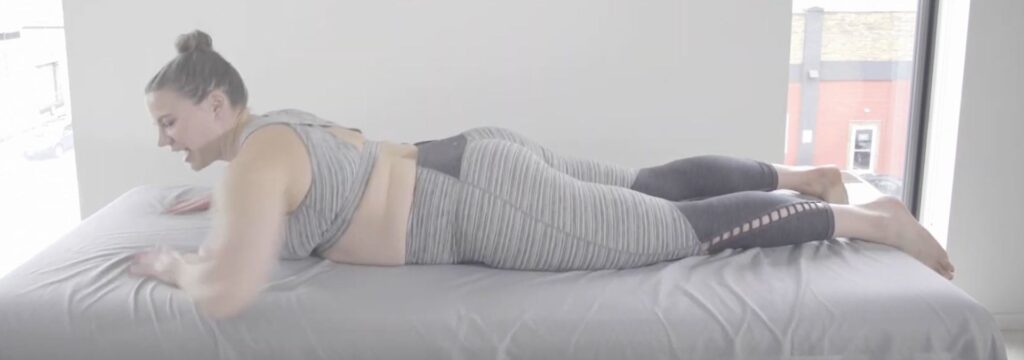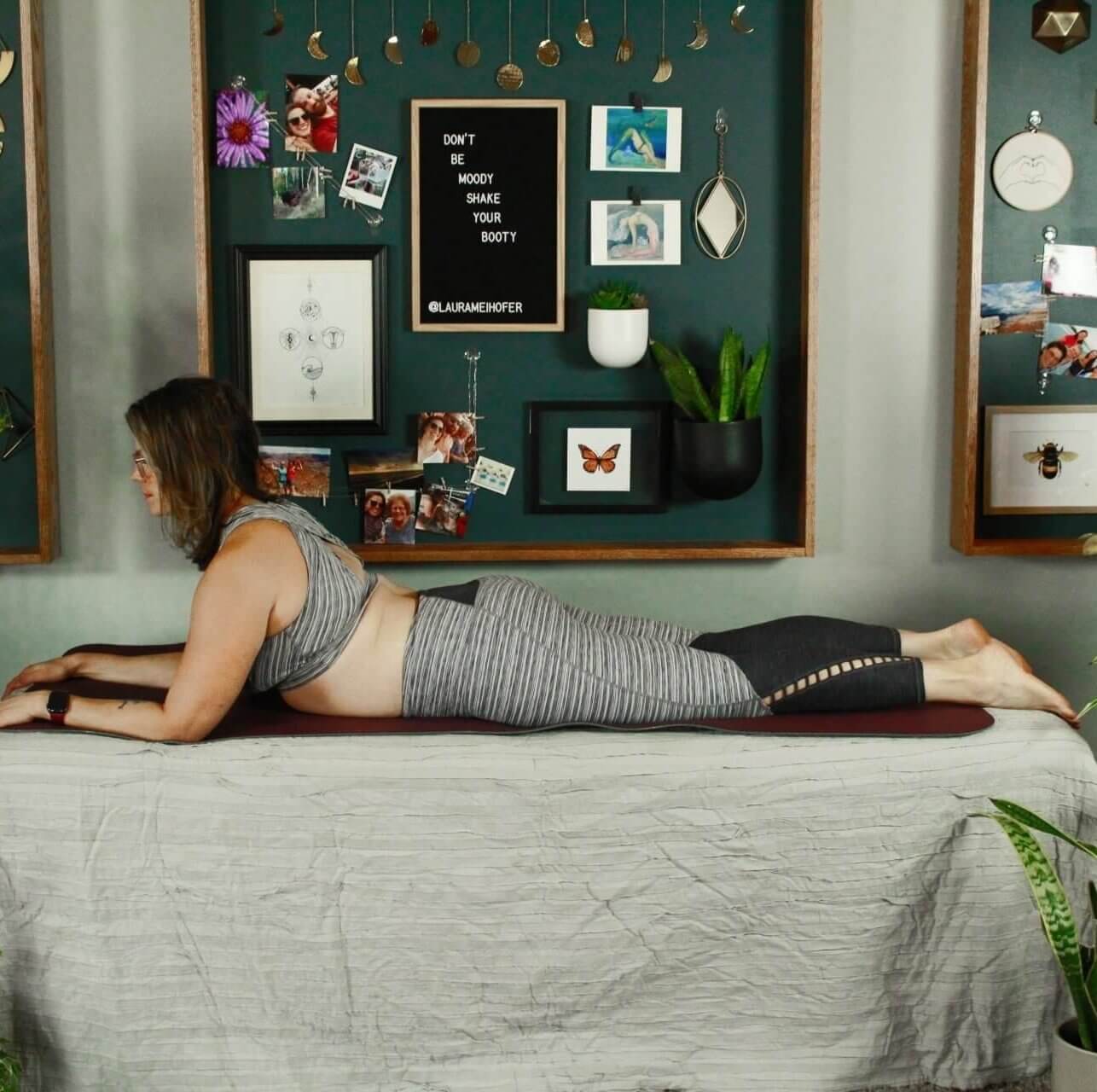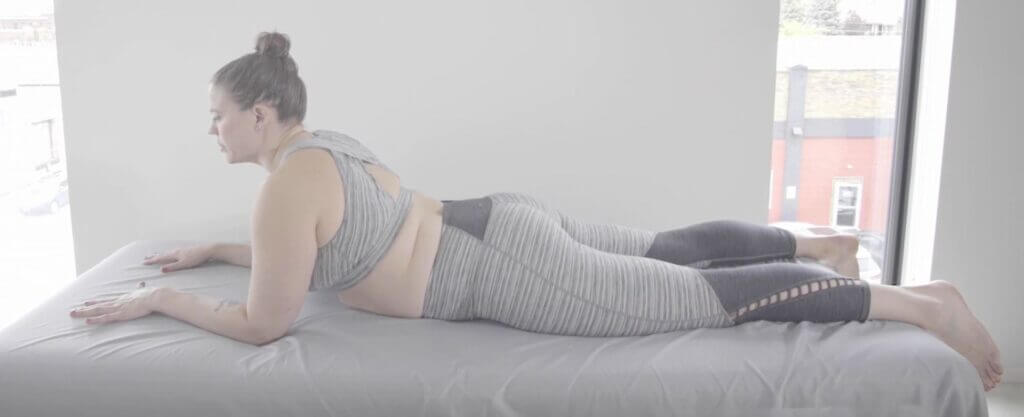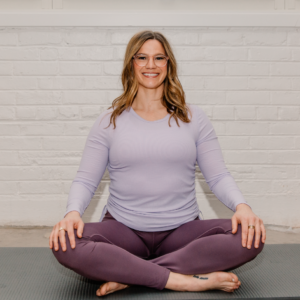Sphinx Pose, or Salamba Bhujangasana, provides a wonderful opportunity for a tip-to-tail stretch through the front of your body and your pelvic floor. If you’re already thinking “Whoa Nelly! I can’t do that!” STOP. LISTEN. I’m here to tell you, YES YOU CAN! I provide a range of modifications below to help you adjust and make this position accessible to you. Sphinx Pose is a yoga position that can be utilized on its own, or within a sequence of yoga poses to treat pelvic floor dysfunction. As a Pelvic Floor Physical Therapist, I help individuals find optimal health through knowledge and movement.
As with all yoga poses, by relaxing deeply, focusing on your diaphragmatic breathing, and find what you need to be supported properly in the guide below. As you can see from the photo above, the Sphinx pose can be demanding on your chest, hips, and lower back at times. Yoga poses are not one size fits all. Everyone has a unique body, comfort level, and set of capabilities. In this article, I walk you through the process of getting into the Sphinx yoga position and offer variations to adjust this position to meet your needs. You can watch me explain this on my
YouTube Channel. If you are looking for a different type of modification or have questions, please
contact me, I’d love to hear from you!
Benefits of Sphinx Pose
- Decrease pain in the pelvic region, abdomen, back, hips, and groin
- Help with conditions associated with pelvic floor dysfunction
- Help combat fatigue and depression
- Provide opening through your chest and shoulders
- Combat the slouch! We all fall into this daily
- Lengthen the front of your body, abdominal and hip muscles
- Helps with digestion
How to do the Sphinx Pose
Practice your
diaphragmatic breathing with this posture 3x daily. Hold for 90 seconds at a time. This hold time is important for your body to transition and down-regulate. It may feel uncomfortable at first. Meet your body where it’s at and breathe through it.
Sphinx Pose: Step 1

Begin by laying on the floor, mat, or support table face down, with your stomach touching the lower surface. Place your legs as close together as your body can comfortably reach. Bring your hands up to rest above your head and prepare to push upwards to complete the stretch. Use this position as a rest position to ease in and out of Sphinx Pose.
Sphinx Pose: Step 2
Move your elbows to rest directly underneath your shoulders and lift your chest, shoulders, and head creating a 90-degree angle in your elbow. Your palms should be face down on the floor. Be sure to keep looking forward, pull up through your chest, shoulders, and the top of your head, expanding and stretching from your tip to your tail. Push into the floor through your hips to expand your pelvic floor. Feel free to just adjust your viewpoint when looking forward, again utilize this position to meet your body where it is at.
Is it a stretch, or is it a pain? A stretch-like pulling sensation is normal, investigate that feeling. It should gradually reduce throughout the posture. Pain on the other hand will not change, or may even increase. If you feel pain, ease out of the position and try it again utilizing one of the modifications.
Modification 1 of Sphinx Pose

If you struggle with the amount of pinching that occurs in your lower back with this stretch, then this modification is for you! You can use anything you have at home for this modification, which is so great. Just grab a stack of blankets or towels and fold them over and/or stack them until you have a comfortable height or position to place underneath your hip bones. From here just lay forward gently, rest for your 90 seconds, and focus on that breathing!
Modification 2 of Sphinx Pose

If Modification 1 does not provide enough flexion relief to your lower back, then try beginning here! This is a great position to bring you rest, relief, and stretching through your front. We spend so much time on things in front of us, it makes a huge difference to provide your body with a little daily time in this extension no matter how it is accessible to you! For Modification 2 simply lay face-down and tummy-down on the surface, place your hands palms-down on the floor, then rest your head on them. If it helps you to get more comfortable, grab a blanket and throw it over you in this position. Try not to fall asleep!
Modification 3 of Sphinx Pose

Blankets are so great because they make for a super easy modification! Many of my patients with elbow, shoulder, or wrist concerns in this position utilize this modification. Take your blankets or towels from Modification 1, move them up, and use them for chest support. Similarly, you can use one or multiple, or even fold them over a few times to increase the height of the support. Remember that you should feel a stretch, so a little discomfort is normal, no discomfort at all is probably not moving your journey forward.
Sphinx Pose can be demanding, especially for anyone with back concerns. I hope that the explanations provided you with a level of comfort to give this a go. If you still don’t feel that Sphinx Pose is something you can do, please reach out to me or
find a physical therapist near you who can answer your questions and help bring you that level of comfort. In order to enjoy the journey, you must first begin it! We’re all in this together.
For a full range of poses and stretches, with a multitude of modifications, check out the following resources! Use these to design an individualized, daily plan to build healthy movement into your life!
How to check in with yourself while doing the Sphinx Pose:
As you work through these stretch options, check-in and ask yourself: Is it a stretch, or is it a pain? A stretch-like pulling sensation is normal, it may feel uncomfortable but investigate that feeling. A stretching sensation should gradually reduce with time and allow you to continue to deepen throughout the position. Pain, alternately, does not change, or may even increase in intensity. If you feel pain, gently ease out of that stretch and try again utilizing a different variation. There are lots of ones to choose from
For a full range of poses and stretches, with a multitude of modifications, check out the following resources! Use these to design an individualized, daily plan to build healthy movement into your life!
More content you may like:














Sorry, the comment form is closed at this time.